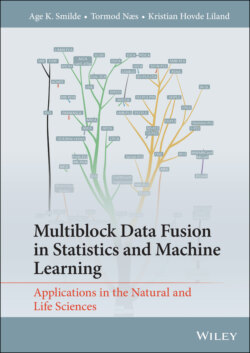Читать книгу Multiblock Data Fusion in Statistics and Machine Learning - Tormod Næs - Страница 44
1.10 Notation and Terminology
ОглавлениеThroughout this book, we will make use of the following generic notation. When needed, extra notation is explained in local paragraphs. For notational ease, we will not make a distinction between population and estimated weights, scores and loadings which is the tradition in chemometrics and data analysis. For regression equations, when natural we do make that distinction and there we will use the symbol b^ or y^ for the estimated parameters or fitted values.
| x | a scalar |
| x | column vector: bold lowercase |
| X | matrix: bold uppercase |
| Xt | transpose of X |
| X_ | three-way array: bold uppercase underlined |
| m = 1,…, M | index for block |
| im = 1,…, Im | index for first way (e.g., sample) in block m (not shared first way) |
| i = 1,…, I | index for first shared way of blocks |
| jm = 1,…, Jm | index for second way (e.g., variable) in block m (not shared second way) |
| j = 1,…, J | index for second shared way of blocks |
| r = 1,…, R | index for latent variables/principal components |
| R | matrix used to compute scores for PLS |
| Xm | block m |
| xmi | i-th row of Xm (a column vector) |
| xmj | j-th column of Xm (a column vector) |
| W | matrix of weights |
| IL | identity matrix of size L×L |
| T | score matrix |
| P | loading matrix |
| E,F | matrices of residuals |
| 1L | column vector of ones of length L |
| diag(D) | column vector containing the diagonal of D |
| ⊗ | Kronecker product |
| ⊙ | Khatri–Rao product (column-wise Kronecker product) |
| * | Hadamard or element-wise product |
| ⊕ | Direct sum of spaces |
When we discuss methods with only one X- and one Y-block we will use the indices JX and JY for the number of variables in the X- and Y-block, respectively. When there are multiple X-blocks, we will differentiate between the number of variables in the X-blocks using the indices Jm(m=1,…,M); for the Y-block we will then use simply the index J. We try to be as consistent as possible as far as terminology is concerned. Hence, we will use the terms scores, loadings, and weights throughout (see Figure 1.2 and the surrounding text). We will also use the term explained variance which is a slight abuse of the term variance, since it does not pertain to the statistical notion of variance. However, since it is used widely, we will use the term explained variance instead of explained variation as much as possible. Sometimes we need to use a predefined symbol (such as P) in an alternative meaning in order to harmonise the text. We will make this explicit at those places.
